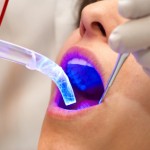
Scaling and root planing (SRP) is a key element in the non-surgical management of periodontitis. A wide range of adjunctive interventions has been investigated to improve the effectiveness of SRP and both lasers and antimicrobial photodynamic therapy (aPDT) have been investigated. Lasers with wavelengths ranging from 635 to 10,600 nm are used to debride connective tissue and epithelium within periodontal pockets, inactivate bacteria and ablate subgingival calculus. While the additional application of laser photons (aPDT) aims to destroying bacterial cells in periodontal pockets by means of highly reactive oxygen radicals produced by a combination of a low-level laser light in conjunction with a photosensitizer.
The aim of this review was to compare the adjunctive effects of lasers or antimicrobial photodynamic therapy (aPDT) to non-surgical mechanical instrumentation alone in untreated periodontitis patients.
Methods
Searches were conducted in the Medline/PubMed, Scopus and Cochrane Central Register of Controlled Trials (CENTRAL), US National Institutes of Health (www.clinicaltrials.gov) and OpenGrey databases. Randomised controlled clinical trials (RCTs), Prospective controlled clinical trials (CCTs) with split-mouth and parallel arms with a follow up period of at least 6 months including ≥20 patients per treatment arm and published in English were considered. The main outcome was pocket probing depth (PD). Papers were initially screened by 4 reviewers with 2 reviewers independently assessing full text articles. Two reviewers independently extracted data with quality being assessed using the domains, sequence generation; allocation concealment; examiner masking; incomplete outcome data and selective outcome reporting. Results of the meta-analysis were expressed as weighted mean differences (WMD) and 95% confidence intervals (CI).
Results
- 17 RCTs were included 10 reported on laser therapy and 8 on PDT (one study including both laser and PDT)
- 370 patients were included in the laser RCTs, 7 were of split mouth design and 3 parallel group.
- The 8 PDT studies included 331 patients, 5 were of split mouth design and 3 parallel group.
- All 17 studies were considered to be at unclear risk of bias.
- 5 different types of laser were used, diode (4 RCTs), Er:Cr:YSGG ( 3 RCTs) Er:YAG , Nd:YAG and potassium titanyl phosphate (KTP) one RCT each.
- Meta-analysis of adjunctive lasers was not performed because of a lack of reporting PD at baseline and 6 months and study heterogeneity.
- All 8 PDT studies used a diode laser, 5 used various concentrations of methylene blue as the photosensitiser, the other 3 used toluidine blue O, phenothiazine chloride or indocyanine green respectively.
- Meta-analysis of PDT (2 studies,41 patients) showed no statistically significant difference, between adjunctive PDT and SRP compare to SRP alone, WMD = 0.35 mm (95%CI; −0.04 to 0.73).
Conclusions
The authors concluded: –
Available evidence on adjunctive therapy with lasers and aPDT is limited by (a) the low number of controlled studies and (b) the heterogeneity of study designs. Patient-reported benefits remain to be demonstrated.
Comments
The authors have searched a good range of databases in order to identify relevant studies but restricting inclusions to publications in English means that some relevant studies may be been excluded. The included studies were small with on average 41 patients (range 22-80) with a majority (10) having no formal power calculation. The studies were also very heterogenous making pooling analysis difficult. None of the studies was assessed as being at high risk of bias for any of the quality domains assessed although equally none of the studies was considered to be at low risk of bias for all domains. Another review limited to lasers as an adjunct to non-surgical periodontal treatment ( Linz et al 2020) has also been recently published. That review included 8 studies, conducting am meta-analysis involving 5 of the included studies but finding no statistically significant benefits in favour of lasers. Any future studies need to be well-designed of appropriate size, include established clinical and patient reported outcomes and be well reported.
Links
Primary Paper
Salvi GE, Stähli A, Schmidt JC, Ramseier CA, Sculean A, Walter C. Adjunctive laser or antimicrobial photodynamic therapy to non-surgical mechanical instrumentation in patients with untreated periodontitis: A systematic review and meta-analysis. J Clin Periodontol. 2020 Jul;47 Suppl 22:176-198. doi: 10.1111/jcpe.13236. PMID: 31859395.
Other references
Lin Z, Strauss FJ, Lang NP, Sculean A, Salvi GE, Stähli A. Efficacy of laser monotherapy or non-surgical mechanical instrumentation in the management of untreated periodontitis patients. A systematic review and meta-analysis. Clin Oral Investig. 2020 Nov 10. doi: 10.1007/s00784-020-03584-y. Epub ahead of print. PMID: 33170372.
Dental Elf – 1st Sep 2015
Aggressive periodontitis: is photodynamic therapy beneficial?
Dental Elf- 17th Oct 2014
Chronic periodontitis: review suggests that Er:YAG laser may provide short term improvement
